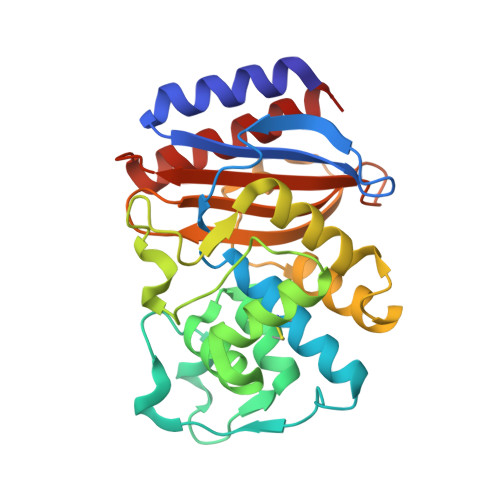Structural and biochemical evidence that a TEM-1 beta-lactamase N170G active site mutant acts via substrate-assisted catalysis
Brown, N.G., Shanker, S., Prasad, B.V., Palzkill, T.(2009) J Biological Chem 284: 33703-33712
- PubMed: 19812041
- DOI: https://doi.org/10.1074/jbc.M109.053819
- Primary Citation of Related Structures:
3JYI - PubMed Abstract:
TEM-1 beta-lactamase is the most common plasmid-encoded beta-lactamase in Gram-negative bacteria and is a model class A enzyme. The active site of class A beta-lactamases share several conserved residues including Ser(70), Glu(166), and Asn(170) that coordinate a hydrolytic water involved in deacylation. Unlike Ser(70) and Glu(166), the functional significance of residue Asn(170) is not well understood even though it forms hydrogen bonds with both Glu(166) and the hydrolytic water. The goal of this study was to examine the importance of Asn(170) for catalysis and substrate specificity of beta-lactam antibiotic hydrolysis. The codon for position 170 was randomized to create a library containing all 20 possible amino acids. The random library was introduced into Escherichia coli, and functional clones were selected on agar plates containing ampicillin. DNA sequencing of the functional clones revealed that only asparagine (wild type) and glycine at this position are consistent with wild-type function. The determination of kinetic parameters for several substrates revealed that the N170G mutant is very efficient at hydrolyzing substrates that contain a primary amine in the antibiotic R-group that would be close to the Asn(170) side chain in the acyl-intermediate. In addition, the x-ray structure of the N170G enzyme indicated that the position of an active site water important for deacylation is altered compared with the wild-type enzyme. Taken together, the results suggest the N170G TEM-1 enzyme hydrolyzes ampicillin efficiently because of substrate-assisted catalysis where the primary amine of the ampicillin R-group positions the hydrolytic water and allows for efficient deacylation.
- Department of Biochemistry and Molecular Biology, Baylor College of Medicine, Houston, Texas 77030, USA.
Organizational Affiliation:


















